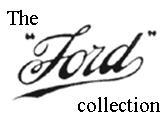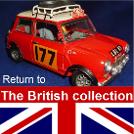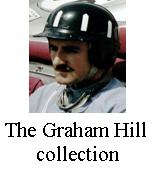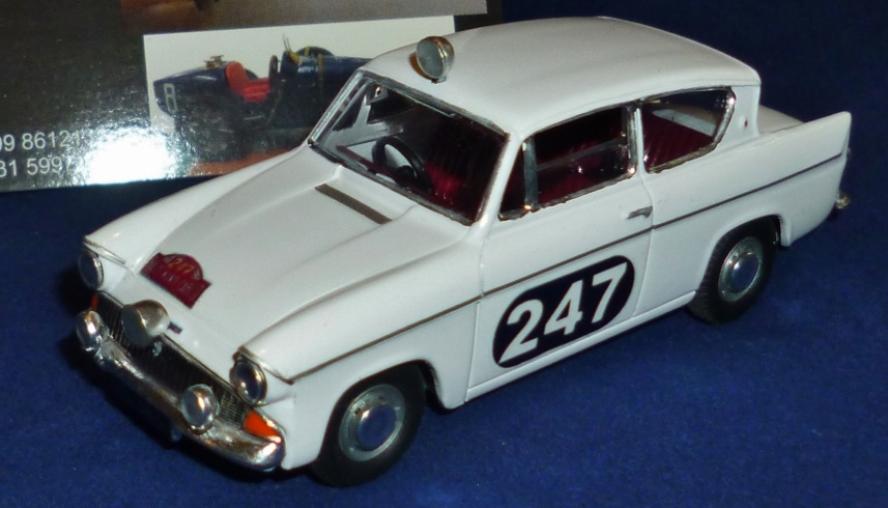
1959-68 Ford 105E Anglia
1959 was one of the great years for car releases. In Britain the Mini was presented to the public, the Triumph Herald and Ford Anglia 105E too. All three had a revolutionary impact. The Mini obviously the greatest effect on the world of car design but the other two in changing how the general public viewed the respective brands. Triumph became a real car for the people, not just for sports or racing, and Ford transformed from its staid family car image to a stylish sporty cars.
The Anglia blazed a path for the 1960s Consul Cortina which Lotus turned into a race winner. Ford's “Total Performance” programme followed. With styling cues from the US, courtesy of visiting Ford USA designer Elwood Engel, the Anglia's reverse-rake rear window (supposedly to keep the rear screen clear of rain), muted rear fins, sweeping bonnet line and hooded head lights, stood out in the market, catching the eye of many potential customers.
The revolution in styling was echoed in the engineering. The old sidevalve engine design was discarded in favour of a new unit, which would become the famous "Kent" engine. An inline straight-four cylinder with an over-square bore/stroke and overhead valves giving 997cc (60.8 cubic in') giving some 36bhp. While the Anglias acceleration was still slow, it was a marked improvement on the earlier Fords.
There was also a new gearbox for the Anglia. A four-speed manual unit with synchromesh on the top three gears. An all-synchromesh gearbox would arrive in late 1962 on the 1198cc versions.
Steering by recirculating ball bearing system was cheap to manufacture and offered advantages in being lighter for the driver, due to reduced friction, and less wear and tear on surfaces in the unit.
An important safety upgrade was the redundancy of the poor vacuum-powered windscreen wipers in favour of a more efficient and reliable electric motor system.
But, the new Anglia did still have the old 100E Anglia's Macpherson strut independent front suspension and breaking remained by drums all round.
Ford refused to let their new design go out to the motoring journals reviewers before convincing themselves of the new Anglia's abilities. 30 different cars were put through the most brutal testing. Anglias were pushed in round-the-clock runs looking for any weaknesses. Speed trials were undertaken on Germany’s Autobahns, roadholding in ice and snow was explored, altitudes of 6,000ft were conquered in East Africa and temperatures over 35C.
From the Alaska Highway and wilds of Canada to the Australian bush, from chilly Norway to the mud tracks of Africa, over 500,000 miles of gruelling dust and suspension tests, high-speed testing, cold starting and heater efficiency; every conceivable aspect of the Anglia 105E was tested. Only when Ford UK was convinced beyond doubt, did the Anglia 105E Standard get unveiled to an expectant world.
Ford hired the Crystal Palace venue to unveil their new Anglia on the 23rd of September 1959. A new for Popular and an updated Prefect also basked in the limelight, but it was the Anglia that made the lasting impression.
After driving the Anglia at 55mph around the Crystal Palace circuit one journalists said: the new gearbox “is a delight to handle and the exciting ‘oversquare’ engine has an exceedingly light throttle to which it responds admirably”.
Ford’s advertising department billed the new car as the “World’s Most Exciting Small Car”, presumably they had been too busy to see the Mini's launch a month earlier.
Overall, the Anglia was lost after the Mini had grabbed the highlights of the press. While the Anglia was a great improvement on previous Ford family cars it wasn't the Mini. It just couldn't grab the journalists views, but the public did accept it with open arms. Between 1959 and 1967, 1,288,956 Anglia 105E based vehicles were produced across the UK, South Africa and Australia. This makes the Anglia a success in both the British and Continental markets.
However, the end of production wasn't the Anglia. Anglias had been family cars, police cars, work vans delivery vans and racing vehicles. They were a great part of many peoples lives and memories. They simple could not be forgotten or ignored.
Countless films and TV appearances have secured the Anglia a special place in popular culture. From Harry Potter to the Young ones, from pop music videos to adverts, graphic art designs and clothing items, Anglias appear in all sorts of forms and roles.
More than 2,000 examples of all styles of Anglia still survive with almost all of them still rolling on the worlds' roads. Never to be forgotten.
One area in which the little Anglia, perhaps surprisingly, had success, was motor sport. The car was barely on sale before engine tuners were using the “Kent” engine in Formula Junior and other spheres of competition. Cosworth Engineering bagged two units for Keith Duckworth to develop and Colin Chapman’s Lotus 18 with a Cosworth III engine and Jim Clark driving became an instant success in FJ.
The almost unbreakable engine, even in tuned form attracted many enthusiasts attention. Six International Class G records were set at the Montlhéry Autodrome in October 1962. John Fitzpatrick won the 1966 British Saloon Car Championship taking 6 out of 8 race victories. Anglias also features in many rallies, from the humble local events to the RAC International and Monte Carlo rallies and all levels in between.
1960 Monte Carlo rally
Our model represents a car from the 29th running of the Rallye Automobile de Monte-Carlo held over the 19th to 23rd of January, 1960. It was a gruelling event on asphalt and snow with severe winter conditions.
The result was the first Monte Carlo win for Mercedes, and a rather convincing one too. The Mercedes-Benz 220SE was a spacious luxury car, but it did have fuel injection and good road-holding capabilities, useful in the difficult mountain motoring conditions. The Rally confirmed the excellence of the 220SE design. Walter Schock & Rolf Moll drove the #128 Mercedes-Benz 220 SE, reg'no. ‘S-JX 190', from Warsaw to 1st O/a. Two more Mercedes took 2nd and 3rd places and in doing so bagged the team prize too. Another Similar Merc’ having finished fifth. DKW were 2nd in the team competition to give the Germans a grand slam.
More entries came from Britain, but took little of the plaudits. The best Brit’s were
Peter Harper & Raymond Baxter driving a Sunbeam Rapier mkIII, #325, reg'no. ‘YWK 5’, to 4th place O/a. Pat Moss-Carlsson and Ann Wisdom-Riley took 17th O/a and the Coupe de Dames. Their #26 Austin A40 Farina, reg'no. ‘947 AOF’ was only 10m39s behind the winners. Anne Hall and Valerie Domleo-Moreley’s Ford Anglia 105E #210 was second in that competition finishing 36th O/a. At least the ladies did well.
While there were a fair number of other British finishers none really stood out in the results list. A British car that stood out for a different reason was the #247 Ford Anglia 105E reg'no. ‘13 SNO’. Starting from Glasgow that car finished 86th O/a. The reason it stood out was that it was being driven by up and coming Formula one driver Graham Hill, with co-driver John Patten. And that's why this model is a part of our collection.
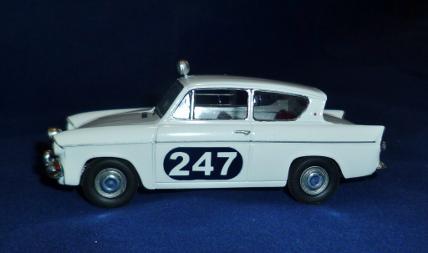
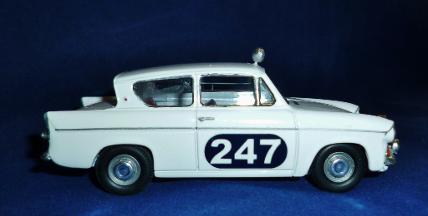
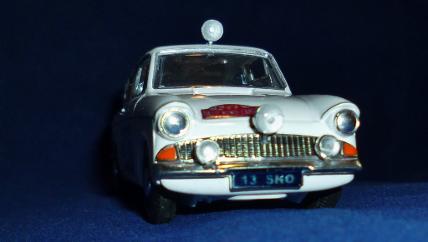
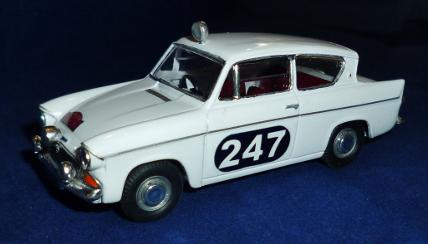

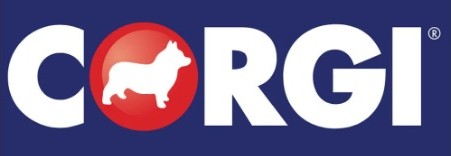
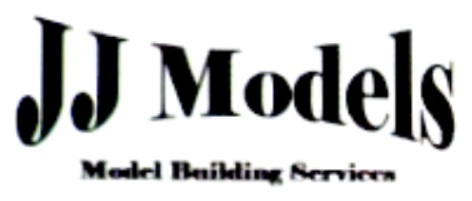
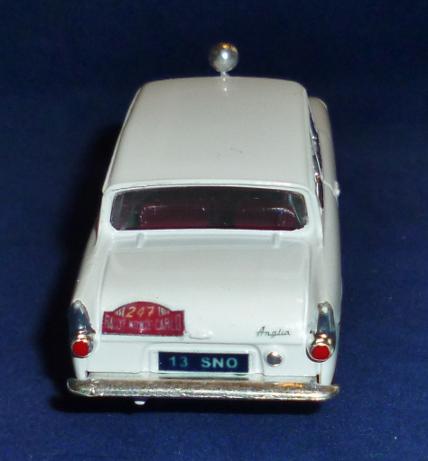
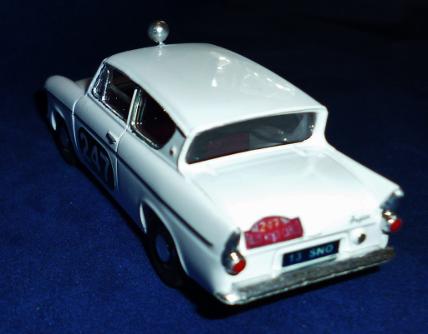
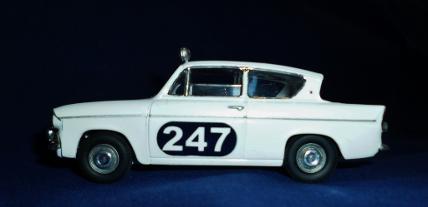
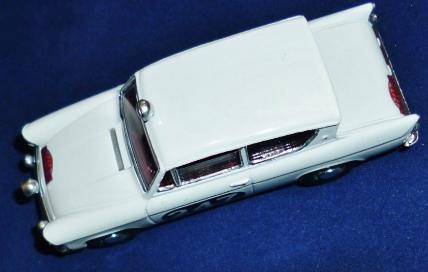
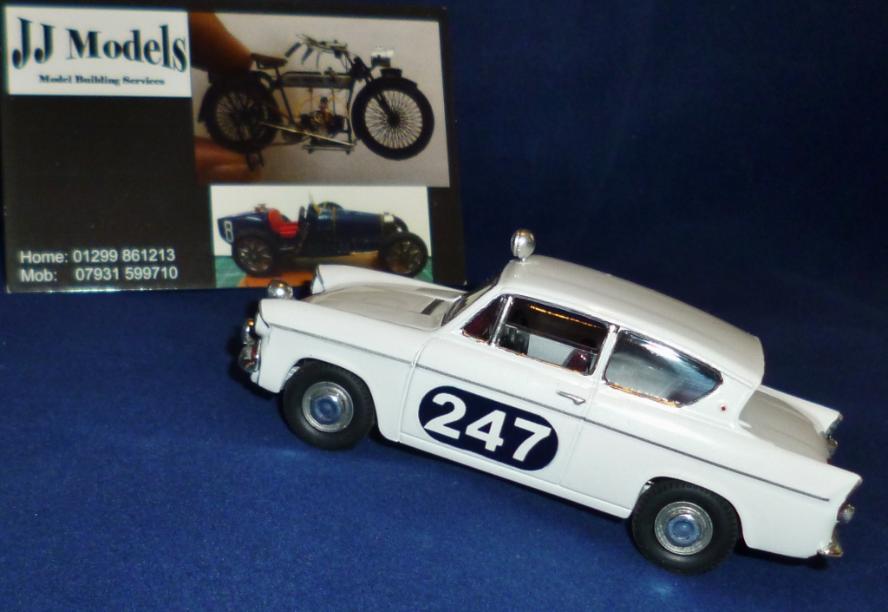
This model was built for us by our good friend John Jenkins. John is a renowned modeller of all subject matter and seemingly can't build a bad model. His shed full of trophies speak to his abilities.
The starting point was a 1/43rd scale CORGI toy of Mr. Weasley's Ford Anglia from the Harry Potter films; #CC99725.
Repainted and with lots of scratch-built rally 'bits' added the model looks far better than the original; in our opinion anyway. If there was ever to be a Ford Anglia 105E in the collection, we can't think of a better version. Or a better person to have built it. Thanks JJ.
RETURN TO :-
